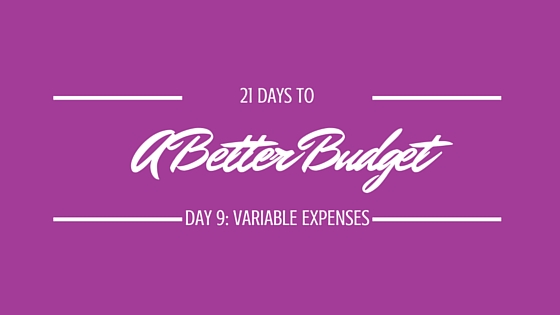
Yesterday we did one of the easier parts of budgeting – identified your fixed expenses. Today, we’re getting a bit more complicated by tackling your variable expenses.
Unlike fixed expenses, which cost the same amount month after month (for example: your mortgage or rent), variable expenses are always changing.
Sometimes they change a lot, sometimes it’s just a few dollars difference.
The most common example of a variable expense is your groceries. It’s all but impossible to spend the exact same amount of money from one month to the next.
Other examples of variable expenses in your family might include:
- Clothing
- Transportation (gas, parking, tolls, etc.)
- Entertainment
- Personal care (like hair cuts, etc.)
- Eating out
- Kids activities – like sports or lessons
- Gifts
Since the amount you need (and want) to spend on these types of variable expenses changes every month, it can be really hard to predict the right amount to budget.
It’s not uncommon, therefore, to find that your spending on one or more these variable expenses quickly spirals out of control.
I have often been asked, “How much should I spend on groceries?” (Or eating out, or clothing, or fill-in-the-blank.)
Unfortunately, I can’t answer this question. Not because I don’t want to help, but because there is no perfect, one-size-fits-all equation.
Spending $200 on groceries might be “too much” for one family; another family could spend $2,000 and still have breathing room.
The right amount to budget for any individual category can only be derived by delicately balancing all of your categories.
Click Here to Subscribe to the FREE 21 Days to a Better Budget Newsletter
Remember when we talked about Zero Balance Budgeting? Income minus expenses must equal zero.
The right amount to spend on groceries, transportation, entertainment or clothing can not be decided in a vacuum.
First, you look at your tracking data. Then, you look at the big picture to figure out what an ideal amount would be. If the two numbers are close, it won’t be too hard to stick to that budget.
If the two numbers are far apart, it may take you some time to close the gap. Let’s take entertainment – that’s a category you can go “cold turkey” on for a month or two or even longer. It’s not going to be fun, but it’s doable.
Clothing – that’s a little trickier (especially if you have kids who seem to outgrow their shoes every other day), but even still, you can certainly cut it back to a bare bones budget.
Groceries are even harder to drastically reduce. Can you cut them? Absolutely! Can you cut them in half or more? You bet you can. But probably not overnight.
Bottom line: Budgeting is a (perpetual) balancing act.
Today’s homework assignment is two-fold:
Part 1: Identify the variable expenses in your budget. (Hint: Most of the things you have been tracking so far are probably variable.)
Part 2: Start delving into the “balancing act”. Ask yourself (and your spouse, if you’re married): What is most important to you/us — where does this fall in the pecking order? Begin to adjust (and readjust) the numbers so that they fit within your Zero Based Budget. This is not an exact science; it’s more like a delicately brushed oil painting. You willneed to continue tweaking this going forward to find the right balance.
There is no doubt that variable expenses are harder to nail down than fixed ones. If you are frustrated right now, that’s completely normal. But I promise you: The more you do this, the easier it will be. You’ve got this!
Click Here to Subscribe to the FREE 21 Days to a Better Budget Newsletter















Leave a Comment